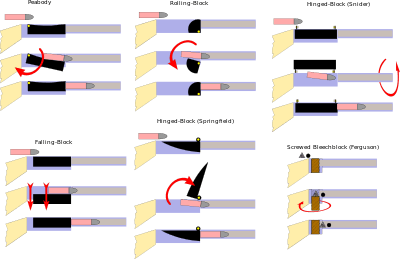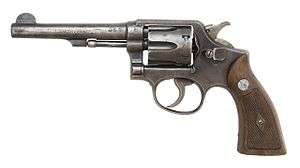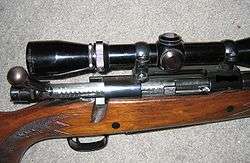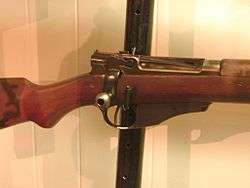Action (firearms)
In firearms terminology, an action is the mechanism that handles the ammunition (loads, locks, fires, and extracts the cartridges) or the method by which that mechanism works. Breech-loading weapons have actions; actions are technically not present on muzzleloaders, as all loading is done by hand. The mechanism that fires a muzzle-loader is called the lock.
Actions can be categorized in several ways, including single action versus double action, break action versus bolt action, and others.
Manual operation
Manual operation is a firearms term describing any type of firearm action that is loaded one shot at a time by the user rather than automatically. For example, break action is a form of manual operation using a simple hinge mechanism that is manually unlatched by the operator, exposing the chamber(s) for reloading.
Single-shot

Dropping block
These are actions wherein the breechblock lowers or "drops" into the receiver to open the breech, usually actuated by an underlever. There are two principal types of dropping block: the tilting block and the falling block.
Tilting block
In a tilting or pivoting block action, the breechblock is hinged on a pin mounted at the rear. When the lever is operated, the block tilts down and forward, exposing the chamber. The best-known pivoting block designs are the Peabody, the Peabody–Martini, and Ballard actions.
The original Peabody rifles, manufactured by the Providence Tool Company, used a manually cocked side-hammer. Swiss gunsmith Friedrich Martini developed a pivoting block action by modifying the Peabody, that incorporated a hammerless striker which was cocked by the operating lever with the same single, efficient motion that also pivoted the block. The 1871 Martini–Henry which replaced the "trapdoor" Snider–Enfield was the standard British Army rifle of the later Victorian era, and the Martini was also a popular action for civilian rifles.
Charles H. Ballard's self-cocking tilting-block action was produced by the Marlin Firearms Company from 1875, and earned a superlative reputation among long-range "Creedmoor" target shooters. Surviving Marlin Ballards are today highly prized by collectors, especially those mounted in the elaborate Swiss-style Schützen stocks of the day.
Falling block

A falling-block action (also known as a sliding-block action) is a single-shot firearm action in which a solid metal breechblock slides vertically in grooves cut into the breech of the weapon and actuated by a lever. Examples of firearms using the falling block action are the Sharps rifle and Ruger No. 1.
Rolling block
In a rolling block action the breechblock takes the form of a part-cylinder, with a pivot pin through its axis. The operator rotates or "rolls" the block to open and close the breech; it is a simple, rugged and reliable design. Rolling blocks are most often associated with firearms made by Remington in the later 19th century; in the Remington action the hammer serves to lock the breech closed at the moment of firing, and the block in turn prevents the hammer from falling with the breech open.
Break-action
A break action is a type of firearm where the barrel(s) are hinged and can be "broken open" to expose the breech. Multi-barrel break action firearms are usually subdivided into over-and-under or side-by-side configurations for two barrel configurations or "combination gun" when mixed rifle and shotgun barrels are used.
Hinged block
The earliest metallic-cartridge breechloaders designed for general military issue began as conversions of muzzle-loading rifle-muskets. The upper rear portion of the barrel was filed or milled away and replaced by a hinged breechblock which opened upward to permit loading. An internal angled firing pin allowed the re-use of the rifle's existing side-hammer. The Allin action made by Springfield Arsenal in the US hinged forward; the Snider–Enfield used by the British opened to the side. Whereas the British quickly replaced the Snider with a dropping-block Peabody-style Martini action, the US Army felt the trapdoor action to be adequate and followed its muzzleloader conversions with the new-production Springfield Model 1873, which was the principal longarm of the Indian Wars and was still in service with some units in the Spanish–American War.
Bolt action
Although bolt actions are usually associated with fixed or detachable box magazines, in fact the first general-issue military breechloader was a single-shot bolt action: the paper-cartridge Prussian Needle Gun of 1841. France countered in 1866 with its superior Chassepot rifle, also a paper-cartridge bolt action. The first metallic-cartridge bolt actions in general military service were the Berdan Type II introduced by Russia in 1870, the Mauser Model 1871, and a modified Chassepot, the Gras rifle of 1874; all these were single-shots.
Today most top-level smallbore match rifles are single-shot bolt actions.
Single-shot bolt actions in .22 caliber were also widely manufactured as inexpensive "boys' guns" in the earlier 20th century; and there have been a few single-shot bolt-action shotguns, usually in .410 bore.
Lever Release
Lever Release is a type of action used in the UK invented and produced by Southern Gun Company. The action was invented to comply with The Firearms (Amendment) Act 1988 which bans possession of semi-automatic rifles. This is because firing 9mm in a closed bolt caused extraction problems so the system was invented to absorb the energy that caused such problems by releasing the bolt. It is a blow-back system where the energy from the previous round is used to eject the empty casing. The spring-loaded bolt is then held back so that another round is not loaded. To load the next round, the shooter must release a small lever on the rifle using the thumb, which frees the bolt to spring forward and feed the next round.
Other actions
- The Ferguson rifle: British Major Patrick Ferguson designed his rifle, considered to be the first military breechloader, in the 1770s. A plug-shaped breechblock was screw-threaded so that rotating the handle underneath would lower and raise it for loading with ball and loose powder; the flintlock action still required conventional priming.
- The Hall rifle: First U.S. cavalry breechloader, originally made in flint but later made-in and converted-to percussion in 1830s-1840s. The breech section tilts up to accept a paper cartridge. Excellent machine-made construction, but still tended to leak gas at the breech.
- The Kammerlader: A crank-operated Norwegian firearm produced around the time of the Prussian Needle-gun. Originally used a paper cartridge. Later many were converted to rimfire; this was the first Norwegian breechloader.
- The Tarpley carbine: This is categorized into falling block action, but the breech block is hinged unlike the others.
- The M1867 Werndl–Holub: Rotating drum action, similar to the rolling block, but with rotation of the block perpendicular to the barrel; uses primed metallic cartridge.
- The Morse Carbine: The mostly brass action is somewhat like Hall rifle, except it was designed to take a special centerfire cartridge. Very few of these were actually made and were constructed in the late 1850s.
- The Joslyn rifle:
- Rising Breech Carbine:
Repeating
Revolver

A revolver houses cartridges in a rotary cylinder and rotates them in-line with the cylinder bore (actually a forcing cone) prior to each shot. Revolvers are most often handguns,[1] however examples of rifles and shotguns and cannon have been made. The cylinder is most often rotated by manipulation of the trigger and/or hammer, although some are "double action" using the manual pull of the trigger to rotate the cylinder and cock the hammer.
Bolt action

In bolt-action firearms, the opening and closing of the breech is operated manually by a bolt. Opening the breech ejects a cartridge while subsequently closing the breech chambers a new round. The three predominant bolt-action systems are the Mauser, Lee–Enfield, and Mosin–Nagant systems.

Straight Pull
The United States Navy adopted the M1895 Lee Navy M1895 straight pull rifle made by Winchester. Modern straight pull rifles are made by Merkel [2] and Blaser.[3]
Lever-action
Lever-action firearms use a lever to eject and chamber cartridges. An example of firearms using lever action are the Winchester Repeating Rifle and Marlin Model 1894.
Tilting Block Action
Though frequently classified as only single-shot firearms, one tilting block rifle usually falls under the category of repeating firearms. The Krag-Petersson Rifle, upon ejecting a round from the chamber, would load a round from the underbarrel magazine onto the loading surface of the tilting block, then raise it to the mouth of the chamber where the user could then easily push it forward into the chamber. Though this would not meet most standards of "repeating" for most modern users, the classification has been in use historically.
Pump-action
In pump action or slide action firearms, a grip called the fore end is manually operated by the user to eject and chamber a new round. Pump actions are predominantly found in shotguns. An example of firearms using the pump action are the Remington 870 and Winchester Model 1897.
Rolling Block Action
A rolling block is a form of firearm action where the sealing of the breech is done with a specially shaped breechblock able to rotate on a pin. The breechblock is shaped like a section of a circle. The breechblock is locked into place by the hammer, thus preventing the cartridge from moving backwards at the moment of firing. By cocking the hammer, the breechblock can be rotated freely to reload the weapon.
The Remington-Rider Magazine Pistol had a manually-actuated block rolled back to pull a cartridge from a tubular magazine set below the barrel and simultaneously cock the weapon. The block was rolled back into battery, loading the cartridge into the chamber, by spring pressure while the hammer remained in the cocked position.
Other actions
- Gatling gun
- Hughes Chain Gun
- French Guycot Chain Rifle
- Kalthoff repeater
- Cookson repeater
- Belton flintlock
- The Jennings Magazine Rifle
- Meigs Sliding Guard Action Repeater
- Roper repeater
- The Orvill Robinson Model 2 rifle: Orvill Robinson, a New York-based firearms designer, developed two rifles. His first, patented in 1870 and commonly referred to by collectors as the "Model 1" though it has no official designation, was a precursor to straight-pull bolt actions like the Mannlicher M1886. The second rifle designed by Robinson, patented in 1872, was very different, employing a double hinged action that folded upward from the receiver to remove the spent casing and back down and forward to chamber a new round. Though hammer-fired, it is recognizable as a manually actuated ancestor of the toggle action found in firearms such as the Luger Parabellum 1908 pistol or Pedersen Rifle.
Automatic actions
Blowback operation
Blowback operation is a system in which semi-automatic and fully automatic firearms operate through the energy created by combustion in the chamber and bore acting directly on the bolt face through the cartridge. In blowback operation the bolt is not locked to the chamber, relying only on spring pressure and inertia from the weight of the bolt to keep the action from opening too quickly. Blowback operation is used for low-powered cartridges due to the weight of the bolt required.
Delayed blowback actions use some mechanism to slow down rearward travel of the bolt, allowing this action to handle more powerful ammunition and/or reduced weight of the bolt.
Examples of blowback operation
- Simple blowback: Halcón M-1943, Uzi submachine gun, Varan PMX-80
- Lever-delayed blowback: FAMAS, Sterling 7.62, AA-52, 2B-A-40, TKB-517
- Roller-delayed blowback: SIG 510, HK MP5, HK P9, HK G3
- Gas-delayed blowback: Volkssturmgewehr 1-5, HK P7, Steyr GB
- Toggle-delayed blowback: Schwarzlose MG M.07/12, Luger rifle and Pedersen rifle
- Blish Lock: early Thompson submachine guns
- Hesitation locked: Remington Model 51 and R51 pistols
- Chamber-ring delayed blowback: Seecamp pistol
Blow-forward operation
Blow-Forward operation is where the firearm lacks a bolt but has a moving barrel that is forced forward by the friction of the projectile against a spring as means of reloading a fresh round.[4]
Examples of blow-forward operation
- Hino Komuro M1908 Pistol
- Steyr Mannlicher M1894
- Schwarzlose Model 1908
- Special Operations Weapon
- Pancor Jackhammer
Recoil operation
Recoil operation is a type of locked-breech firearm action used in semi-automatic and fully automatic firearms. It also uses energy from the combustion in the chamber acting directly on the bolt through the cartridge head, but in this case the firearm has a reciprocating barrel and breach assembly, combined with a bolt that locks to the breach. The breach remains locked as the bolt and barrel travel rearward together for some distance, allowing pressure in the chamber to drop to a safe level before the breech is opened.
Examples of recoil operation
- Short-recoil: Colt M1911, MAB PA-15, Browning Hi-Power, HK USP, Glock, Mamba Pistol, M2 Browning machine gun, MG42, Vz 52 pistol, M82
- Long-recoil: Browning Auto 5, Femaru STOP Pistol, Mars Automatic Pistol, Chauchat
- Inertia: some Benelli shotguns
Gas operation
Gas operation is a system of operation used to provide energy to semi-automatic and fully automatic firearms. In gas-operation, a portion of high pressure gas from the cartridge being fired is tapped through a hole in the barrel and diverted to operate the action. There are three basic types: long stroke gas piston (where the gas piston goes the same distance as the operating stroke of the action parts, and is often attached to the action parts), short stroke gas piston (where the gas piston goes less than distance as the operating stroke of the action parts), and direct impingement (AKA "direct gas", "gas impingement", where there is no piston, and the gas acts directly on the action parts). A fourth type, now considered obsolete and ineffective, are those systems based on the Bang rifle that utilize a muzzle cap to capture gas after the bullet has left the barrel. While this system is successful in boosting the operating power of recoil operated guns, it is insufficient and too susceptible to fouling for use as the primary operating system.
Examples of gas operation
- Short-stroke gas piston: FN FAL, SAR-87, HK G36
- Long-stroke gas piston: M1 Garand, AK-47, FN FNC
- Direct impingement: MAS 49, M16, AG-42
- Gas trap: Gewehr 41, Bang M1922 rifle[5]